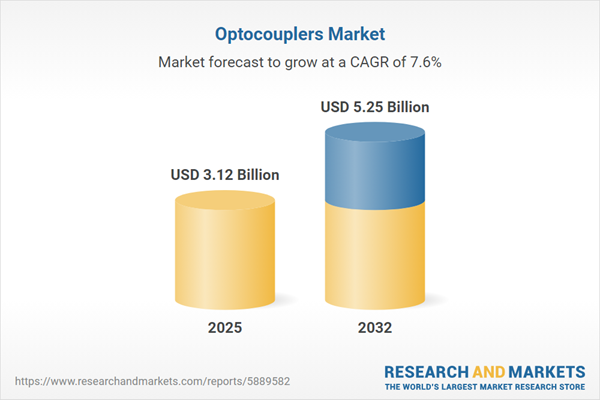Speak directly to the analyst to clarify any post sales queries you may have.
Optocouplers are fundamental for modern enterprise infrastructure, providing secure signal isolation and reinforcing operational reliability as organizations refine procurement and compliance models. This overview addresses the principal trends, key market segments, and strategic imperatives shaping the optocouplers market for senior decision-makers navigating digital transformation.
Market Snapshot: Optocouplers Market Size and Growth
The optocouplers market continues to record strong compound annual growth, driven by widespread adoption of advanced isolation and signal noise management solutions. These technologies are increasingly integrated into power management, industrial automation, and communications systems to secure data transfers and support business continuity. Heightened focus on operational resilience, adaptive global sourcing, and regional electrification projects accelerates market expansion. Varied regulatory landscapes across regions further influence compliance-driven procurement, enhancing risk management approaches. This environment sustains the optocouplers market’s alignment with the digitalization objectives of leading enterprises.
Scope & Segmentation in the Optocouplers Market
This analysis enables procurement and technology leaders to tailor sourcing strategies to distinct needs and evolving regulatory environments across the optocouplers ecosystem:
- Device Types: Photo-SCR, Photo-TRIAC, Photodarlington, Photodiode-based, and Phototransistor-based models support secure signal transfer and redundancy for targeted operational scenarios.
- Input Types: AC and DC-compatible solutions facilitate modernization of legacy systems and seamless execution of high-performance initiatives.
- Isolation Voltages: Selection spans below 500V, 500V–1000V, and above 1000V, ensuring compliance with varying safety and sector-specific risk standards.
- Output Current Ranges: Configurations from low to high current meet diverse integration requirements, from sensitive data flows to equipment with heavy electrical loads.
- Packaging Formats: Dual In-line Package (DIP), Plastic Dual In-line Package (PDIP), and Small Outline Integrated Circuit (SOIC) formats enable flexible manufacturing and streamlined production lines.
- Application Areas: Communications infrastructure, motor controls, power management, and industrial automation all leverage optocouplers to enhance efficiency, safety, and compliance tracking.
- End-use Sectors: Aerospace and defense, automotive, healthcare, consumer electronics, renewable energy, and telecommunications demand optocouplers for evolving performance and risk mitigation needs.
- Sales Channels: Both offline and digital procurement channels address fast-changing sourcing demands and help strengthen supply chain resilience.
- Regions Covered: Americas, Europe, Middle East and Africa, and Asia-Pacific regions each present their own compliance and logistics challenges, influencing sourcing decisions and supplier relationships.
Leading the market, Broadcom Inc., Infineon Technologies AG, Texas Instruments Incorporated, Toshiba Corporation, and Vishay Intertechnology Inc. propel technical advancement and influence sourcing for global manufacturers and system integrators.
Key Takeaways for Strategic Decision-Makers
- Align optocoupler selection with organizational infrastructure and evolving operational requirements, reducing integration risk during upgrades.
- Partner with technology-forward suppliers to optimize product lifecycle, compatibility, and performance in mission-critical environments.
- Implement robust procurement frameworks, featuring regular regulatory and supplier reviews to address changing compliance dynamics and maintain adaptability.
- Evaluate packaging and electrical characteristics early in sourcing to streamline maintenance and manage total cost of ownership.
- Advance digital procurement strategies to reinforce supply chain continuity in periods of market volatility or disruption.
Tariff Impact: Navigating 2025 Procurement Pressures
Pending tariff changes will require targeted planning to maintain cost efficiency and supply reliability. Senior executives should pursue dual-sourcing, ongoing scenario analysis, and regular supplier performance reviews to mitigate potential supply chain risk. Strong supplier collaboration and vigilant compliance expense tracking help ensure operational stability as trade dynamics fluctuate.
Methodology & Data Sources
This report draws on interviews with procurement and engineering leaders, an extensive review of technical specifications, and current market data analysis. Scenario-based modeling equips senior managers to anticipate supply chain or compliance shifts affecting sourcing strategies.
Why This Report Matters
- Empowers leaders to optimize technology investments to support digital modernization and organizational sustainability targets.
- Enhances supplier selection and risk management processes, improving supply chain flexibility across key industries.
- Delivers actionable recommendations for procurement, operational, and regulatory strategies in a rapidly evolving market landscape.
Conclusion
This report provides senior decision-makers with the strategic perspective to drive agile procurement, strengthen supply chain resilience, and sharpen risk management as the optocouplers market advances. Focused adaptation will sustain enterprise stability and future opportunities.
Additional Product Information:
- Purchase of this report includes 1 year online access with quarterly updates.
- This report can be updated on request. Please contact our Customer Experience team using the Ask a Question widget on our website.
Table of Contents
3. Executive Summary
4. Market Overview
7. Cumulative Impact of Artificial Intelligence 2025
Companies Mentioned
The companies profiled in this Optocouplers market report include:- Broadcom Inc.
- Cosmo Electronics Corporation
- Everlight Electronics Co. Ltd
- Groupe celduc
- ICStation.com
- Infineon Technologies AG
- Isocom Ltd
- LITE-ON Technology Corporation
- Littelfuse, Inc.
- Ningbo Qunxin Microelectronics Co., Ltd.
- NTE Electronics Inc.
- ON Semiconductor Corporation
- Panasonic Corporation
- Renesas Electronics Corporation
- ROHM Co., Ltd.
- Senba Sensing Technology Co. Ltd
- Sharp Corporation
- Shenzhen Kento Electronic Co. Ltd
- Shenzhen Orient Components Co. LTD
- Siemens AG
- Skyworks Solutions Inc.
- Standex Electronics Inc.
- STMicroelectronics N.V.
- Taiwan Semiconductor Manufacturing Company Limited
- Texas Instruments Incorporated
- Toshiba Corporation
- TT Electronics PLC
- Vishay Intertechnology Inc.
- Xiamen Hualian Electronics Co.,Ltd.
Table Information
| Report Attribute | Details |
|---|---|
| No. of Pages | 182 |
| Published | November 2025 |
| Forecast Period | 2025 - 2032 |
| Estimated Market Value ( USD | $ 3.12 Billion |
| Forecasted Market Value ( USD | $ 5.25 Billion |
| Compound Annual Growth Rate | 7.6% |
| Regions Covered | Global |
| No. of Companies Mentioned | 30 |









